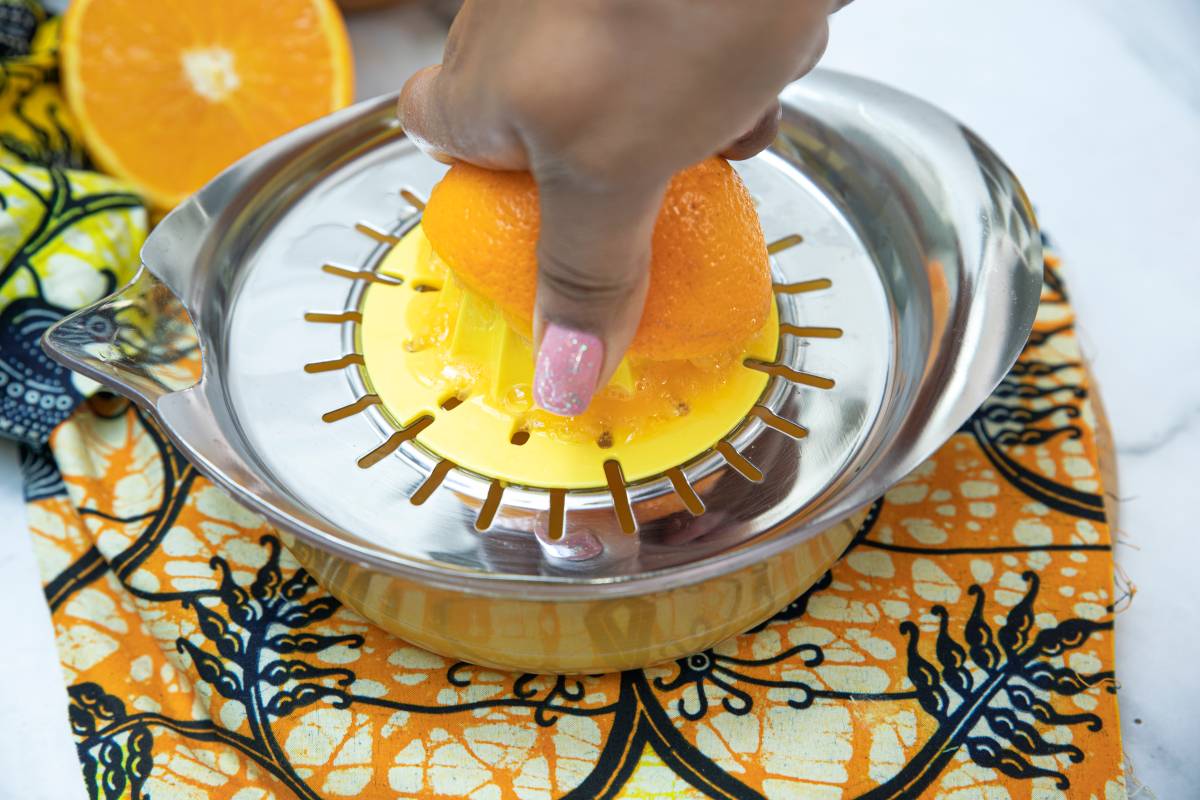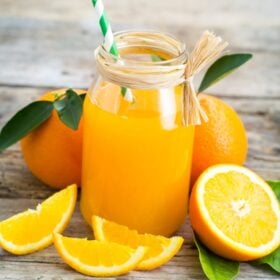Fresh Made Orange Juice Recipe In Under 10 Minutes
If you want a refreshing kickstart to your day, you must try my fresh-squeezed orange juice recipe. It is easy, delicious, and takes less than 10 minutes to make!
If you love today’s fresh orange juice recipe, you will also love this Sugar-Free Pineapple Cucumber Juice and my famous Jugo De Remolacha Y Naranja recipe. But make sure to go check out my website for loads more! There is bound to be one you fall in love with!
Let’s take a look at how to make orange juice at home.

Why I Love This Fresh-Made Orange Juice Recipe
There are honestly so many reasons why I am obsessed with making freshly squeezed orange juice at home, I don’t even know where to begin!
- Unprocessed Ingredients: Making your orange juice ensures everything is natural. You get to decide whether to use store-bought, organic, or GMO-free oranges. The power of choice extends to the sweetener as well—you can opt for honey-flavored syrup or raw honey. This freedom means no unwanted preservatives, artificial flavorings, or colorants.
- Simplicity in Ingredients: The recipe is beautifully straightforward—freshly squeezed orange juice, a touch of honey for sweetness, and mint for a refreshing twist. Remember, oranges already contain natural sugars, so a little honey goes a long way in enhancing the flavor without overwhelming it.

Tips And Tricks For Making Orange Juice With a Juicer
- For this tutorial on making homemade orange juice, you need a blender. You can also use a juicer or food processor if you don’t have one. Unfortunately, not many other tools can juice oranges in the same way. Even a hand juicer will be very labor-intensive and take a long time.
- If you still want to add sweetness without the calories, you can try using Stevia. For this juice recipe, you will only need a couple of pinches of sugar. Don’t overdo it because you can create an overly sweeter juice.
- If your fresh oranges are exceptionally hard, you can soften them in the microwave. Only put them in for 10 seconds. That will make them easier to cut and help them release more juice from their pulp. It’s a great method to make a citrus juicer, especially for hand-squeezing fruit juice.
- Add mint leaves or ginger if you want to add more flavor to your fresh-squeezed orange juice. Do not add dried mint leaves or ginger powder. These ingredients have to be fresh; otherwise, the taste of the juice will be off.

TIPS AND TRICKS FOR MAKING ORANGE JUICE WITHOUT A BLENDER
YOU CAN USE A MANUAL JUICER
A manual juicer, or a citrus juicer, is a great choice if you want to avoid having a lot of cleaning to do afterward.
First, use a manual juicer to cut the oranges in half and juice them. Next, take the filter and place it over the bowl.
If you don’t have a strainer, you can also line the bowl with a coffee filter or cheesecloth. This will help to remove any pulp or seeds that may have made their way into the juice.
Once you have strained the fresh-squeezed orange juice, it’s ready to drink!

You Can Use An Electric Juicer
An electric juicer will make the process much easier and quicker. If you have an electric citrus juicer, simply cut the oranges in a quarter and juice them. The pulp and seeds will be collected in a container.
If you want pulp-free juice, you can strain the juice a second time with a coffee filter or cheesecloth. I personally like a little bit of pulp in my fresh-squeezed orange juice, but it’s up to you!
If You Don’t Have A Juicer
You can also make this juice in a food processor. Cut the oranges into small pieces and add them to the food processor. Pulse until the oranges are liquified.
Then, pour the mixture into a strainer over a bowl and press down on the pulp with a spoon to extract all of the fresh-squeezed orange juice.
You Can Also Make Fresh-Squeezed Orange Juice With No Gadgets At All
You can use your hand to squeeze the juice out. This is a bit more labor-intensive, but it’s still doable.
To do this, massage the oranges a bit to soften them up and help release the juice. Next, cut them in half and squeeze the juice into a bowl. Keep pressing until all of the juice has been extracted. Repeat with the remaining orange halves.
Once you have squeezed all of the fresh-squeezed orange juice out, you can drink it as is or strain it to remove any pulp or seeds.

FAQs
Yes. When you make fresh-squeezed orange juice, you can freeze them in quality freezer bags. Make sure to squeeze as much air as possible out of the bags before sealing them. You can freeze your orange juice good in ice cube trays for easier storage and thawing.
Here are some good tips to freeze your homemade juice.
The best oranges to use for making fresh juice are sweet oranges, such as navel oranges and Valencia oranges. There are a few different ways to make fresh-squeezed orange juice, but always make sure that you use a fresh fruit.
When freshly squeezed orange juice is left to stand, it develops limonin, a bitter component. It isn’t present when orange juice is first squeezed, but time and heat help it develop this bitter taste.
That’s why fresh orange juice is so rare and should be consumed immediately. That is also why so many manufacturers add chemicals to the juice.

Homemade Fresh Orange Juice Recipe
Ingredients
- 8 large oranges
- A small piece of ginger, peeled
- 3 mint leaves, washed, decoration
Instructions
- First, peel all of the oranges.
- Then, remove the white membrane of the oranges carefully. Try to take off as much as you can (they add a bitter flavor to the juice).
- Cut each orange into quarters. Use a fork to remove all of the seeds inside.
- Next, add the prepared orange pieces into a blender jar.
- Then, add the peeled piece of ginger, and blend the ingredients together until you have a completely uniform juice.
- If you don't like pulpy juice, you can strain it through a muslin cloth of fine-mesh strainer. And, if you liek a specific amount of pulp, you can always add some strained pulp back into your juice.
- Enhance the taste of your orange juice by serving it with a garnish of fresh mint leaves. Whether served immediately or stored in the refrigerator for several days, this simple addition can provide an added layer of flavor to your beverage.



